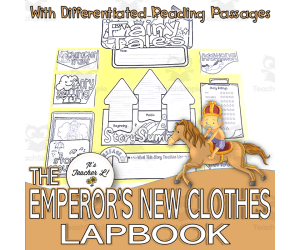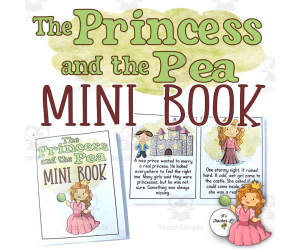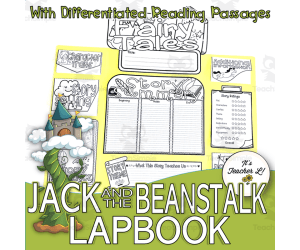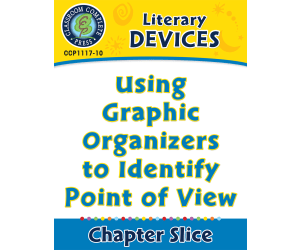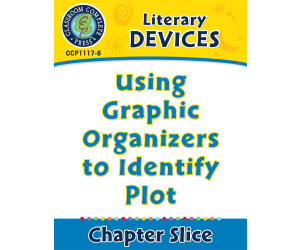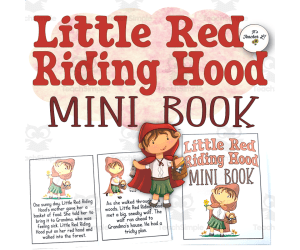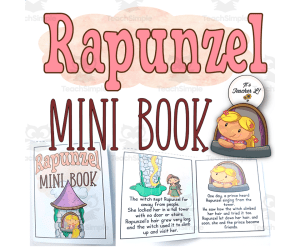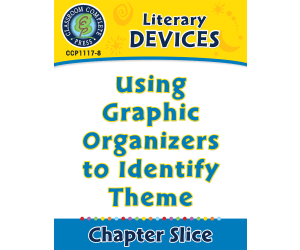2,776 products added recently
Literature Graphic Organizers
Enhance literary analysis by providing graphic organizers that help students dissect texts. This collection includes character maps, theme trackers, and plot diagrams. By integrating these tools, you encourage students to explore literature more profoundly and develop analytical skills.
The Steadfast Tin Soldier Lapbook Project Reading Writing Grades 3 4 5
Language Development, ELA, ESL, Literature, Literary Devices, Children’s Literature, Reading Comprehension, Reading, Strategies, Grade 3, 4, 5, Activities, Crafts, Centers, Projects, Graphic Organizers, Teacher Tools, Templates
Encourage strength of spirit through the classic tale of The Steadfast Tin Soldierwith this The Steadfast Tin SoldierLapbook Project . This purposeful resource is created for Grades 3, 4, and 5 students, homeschoolers and EFL/ESL learners and designed to be used for reading classes, reading centers, fairy tale units, reading comprehension assessment tool, sub plan and more! Contents: •3 The Steadfast Tin SoldierLapbook Leveled Reading Passages (Easy, Average, and Hard) •6 The Steadfast Tin SoldierLapbook Cover Options •2 The Steadfast Tin SoldierLapbook Name Page Designs (for individual or group use) •1 The Steadfast Tin SoldierLapbook Inner Overlap Panel •3 The Steadfast Tin SoldierLapbook Story Summary Page Formats •2 The Steadfast Tin SoldierLapbook Thematic Message Pages •2 The Steadfast Tin SoldierLapbook Pockets for Story Sequence Cards •6 The Steadfast Tin SoldierLapbook Illustrated Sequence •3 The Steadfast Tin SoldierLapbook Sets of Sequencing Cards – Easy, Average, and Hard (6 cards each) •6 The Steadfast Tin SoldierLapbook Story Retell Cards •1 The Steadfast Tin SoldierLapbook Character Traits Fold •1 The Steadfast Tin SoldierLapbook Story Setting Fold •1 The Steadfast Tin SoldierLapbook Additional Information Foldable •1 The Steadfast Tin SoldierLapbook Story Rating Page •1 The Steadfast Tin SoldierLapbook Reflection Fold
Author It's Teacher L
Rating
Tags The Steadfast Tin Soldier, Fairy Tales, Reading Comprehensio, Reading Centers, ELA Project
What are Myths, Fables, Legends, and Fairy Tales?
ELA, Literature, Reading, Writing, Grade 3, 4, 5, Drawing Templates & Outlines, Worksheets & Printables, Worksheets, Graphic Organizers, Teacher Tools, Outlines
Brief Activity Overview: In this activity, your child will explore the unique features of myths, fables, legends, and fairy tales . They will watch a short video and use a chart to organize what they’ve learned about each type of story. At the end of this document, be sure to check out the "Beyond the Activity" section for fun extension ideas if your child wants to dive deeper into these story types or try related lessons. Estimated Time: Less than 1 hour Learning Objective: Understand and identify key features of myths, fables, legends, and fairy tales. Subject: English Language Arts Recommended Grade Levels: 3rd – 6th Getting Started: Exploring Story Types Begin by engaging your child in a simple conversation to spark interest and activate prior knowledge: Tell me about one of your favorite storybooks. Suggested discussion questions are included as great way to ease into the lesson and connect your child’s personal reading experiences to the bigger ideas behind storytelling. Introducing the Activity Discuss how many stories fall into categories such as myths, fables, legends, and fairy tales and what your child knows about them (guiding questions are provided). Then, explain that in this activity, they’ll learn more about each type by watching a brief video and taking notes. Encourage them to pay attention to the key features of each story type and notice how they are alike and different . What to Do Next Watch the Video – Invite your child to watch the short video provided. Take Notes – As they watch, encourage them to jot down what they learn about myths, fables, legends, and fairy tales. Discuss and Reflect – After watching, go over the comprehension questions on the next page. These questions can be used: As discussion starters As writing prompts Or a combination of both—whatever works best for your family! 💡 An answer key is included to support your discussion.
Author Sprout & Inspire
Rating
Tags Reading, Myth, Fable, Legend, Fairy Tale, Graphic Organizer, Quick Activity, Ela
The Emperor’s New Clothes Lapbook Project ELA Grades 3 4 5
ELA, Language Development, ESL, Reading Comprehension, Reading, Strategies, Literature, Literary Devices, Children’s Literature, Grade 3, 4, 5, Centers, Activities, Crafts, Projects, Assessments, Teacher Tools, Graphic Organizers, Templates
Start the parade through the classic tale of The Emperor’s New Clotheswith this The Emperor’s New ClothesLapbook Project! Perfect for reading classes, ELA activities, reading centers, reading comprehension supplemental tool, reading project, subplan and so much more! What’s Inside: 3 The Emperor’s New ClothesLapbook Leveled Reading Passages (Easy, Average, Hard) 6 The Emperor’s New ClothesLapbook Customizable Lapbook Covers 2 The Emperor’s New ClothesLapbook Name Page Formats (for solo or group project) 1 The Emperor’s New ClothesLapbook Inner Overlap Template 3 The Emperor’s New ClothesLapbook Story Summary Pages 2 The Emperor’s New ClothesLapbook Moral Message Pages 2 The Emperor’s New ClothesLapbook Event Pockets 6 The Emperor’s New ClothesLapbook Story Sequence Cards 3 The Emperor’s New ClothesLapbook Sets of Sequence Cards (graded by difficulty – 6 per set) 6 The Emperor’s New ClothesLapbook Retelling Cards 1 The Emperor’s New ClothesLapbook Character Traits Fold 1 The Emperor’s New ClothesLapbook Setting Fold to 1 The Emperor’s New ClothesLapbook Extra Info Fold 1 The Emperor’s New ClothesLapbook Story Review Page 1 The Emperor’s New ClothesLapbook Personal Reflection Fold
Author It's Teacher L
Rating
Tags The Emperor's New Clothes, Reading Comprehension, Fairy Tale, ELA Project, Reading Centers
The Nightingale Lapbook Project Reading & Writing Grades 3 4 5 ELA
ESL, Language Development, ELA, Literary Devices, Literature, Reading Comprehension, Reading, Strategies, Grade 3, 4, 5, Centers, Activities, Crafts, Projects, Assessments, Teacher Tools, Graphic Organizers, Templates
Discover the amazing tale of The Nightingalethrough this dynamic The Nightingale Lapbook Project made especially for Grades 3, 4, and 5 learners, homeschoolers and EFL/ESL students. This interactive resource is packed with activities for your reading class, reading centers, ELA projects, fairy tale units, and reading comprehension assessment tool and so much more! What’s Inside: •3 The Nightingale Lapbook Leveled Reading Passages (Easy, Average, Hard) •6 The Nightingale Lapbook Unique Cover Options •2 The Nightingale Lapbook Name Page Versions (for individual and group projects) •1 The Nightingale Lapbook Center Page •3 The Nightingale Lapbook Story Summary Templates •2 The Nightingale Lapbook Theme and Message Pages •2 The Nightingale Lapbook Sequencing Pockets •6 The Nightingale Lapbook Picture Event Cards •3 The Nightingale Lapbook Event Sequencing Sets – Easy, Average, Hard (6 cards each) •6 The Nightingale Lapbook The Nightingale Lapbook Retell Cue Cards •1 The Nightingale Lapbook Character Foldable •1 The Nightingale Lapbook Setting Accordion Fold •1 The Nightingale Lapbook Story Elements Foldout •1 The Nightingale Lapbook Book Rating Page •1 The Nightingale Lapbook Personal Connection Page
Author It's Teacher L
Rating
Tags The Nightingale, Reading Comprehension, ELA Project, Reading Centers
Literary Devices: Using Graphic Organizers to Identify Setting
ELA, Literature, Common Core, Grade 5, 6, 7, 8, Graphic Organizers, Teacher Tools
Literary Devices: Using Graphic Organizers to Identify Setting This all-encompassing educational tool focuses on the vital elements of literature such as setting, plot, theme, point of view, foreshadowing and flashback, symbolism and irony. It is not just about offering clear-cut definitions but also providing enough practice opportunities for students. Using Graphic Organizers to Identify Setting This chapter guides students in understanding how settings can define stories. By using graphic organizers – a form of visual learning -, students get better at storing information making it easier to decipher the significance of setting within a literary work. Suitability & Use This product caters follower wide range - whether executed in whole groups or small groups or given as homework. The aim here is ensuring that it adapts best according to your classroom requirements. Structured Learning: This resource aligns with Bloom’s Taxonomy of Learning ensuring its educational pertinence and efficiency. Ready-to-use: Comprising 24 pages that are ready-to-print which are contained within a single PDF file allow for convenient usage without any extra provisions needed. Matching up with Grade 5 to Grade 8 grade levels’ Common Core State Standards - this tool ensures strict adherence towards meeting expectations related to Language Arts focusing specifically on Literature subdomain. Creative Narration & Interactive Activities:The blend of engaging narration styles accompanied by involving activities like interpretation symbols or identifying storylines using graphic organizers ensures student's deep understanding about storytelling fundamentals. When you wish for improving your student's literature assessment skills effectively while having fun during that process then Literary Devices: Using Graphic Organizers To Identify Setting* proves itself as an exceptionally profitable addition. Not only does it add to their knowledge but also creates an intrigue about language arts.
Author Classroom Complete Press
Tags Language Arts, Literary, Literature, Graphic Organizers, Word Search
The Princess and the Pea Fairy Tale Foldable Mini Book Grade 1 2 3 ELA
ESL, Language Development, ELA, Children’s Literature, Literature, Reading Comprehension, Reading, Handwriting, Writing, Grade 1, 2, 3, Centers, Activities, Crafts, Projects, Assessments, Teacher Tools, Graphic Organizers
Develop the necessary literacy skills of your young learners through this purposefully made The Princess and the PeaMini Book Pack. Created for Grades 1, 2 and 3 students, homeschoolers, and EFL/ESL learners, this resource is designed for reading classes, reading centers, reading comprehension exercises, writing practice, fine motor skills exercises, fairy tale units, supplemental assessment tool, morning work, early finisher additional activities, and so much more! What’s Included: •The Princess and the PeaStory Mini Book– for story retelling, reading and reading comprehension practice •The Princess and the PeaStory Mini BookTrace & Read Pages– handwriting practice and motor skills exercise •The Princess and the PeaMini BookSequencing Booklet– sequencing and sorting exercise, story retelling and reading practice •The Princess and the PeaMini BookRetell & Reflect Pages– retell practice, creativity and imagination development •The Princess and the PeaMini BookBlank Create-a-Story Templates– story telling, supporting creative and imaginative thinking skills •The Princess and the PeaMini BookTeacher Guide + Sample Lesson Plan
Author It's Teacher L
Rating
Tags The Princess And The Pea, Reading Comprehension, ELA Project, Reading Centers
The Frog Prince Lapbook Project Reading & Writing Grades 3 4 5 ELA
Language Development, ELA, ESL, Children’s Literature, Literature, Reading Comprehension, Reading, Strategies, Grade 3, 4, 5, Activities, Centers, Projects, Assessments, Teacher Tools, Graphic Organizers, Templates, Crafts
Bring the magic of the timeless tale of The Frog Prince through this The Frog Prince Lapbook Project. Designed for Grades 3, 4 and 5 students, homeschoolers and ESL/EFL learners, this fun and engaging resource is perfect for reading classes, fairy tale unit, reading centers, and assessment tool for reading comprehension activities. What’s Included: •3 The Frog Prince Lapbook Differentiated Reading Passages (Easy, Average, and Hard) •5 The Frog Prince Lapbook Cover Design Choices •2 The Frog Prince Lapbook Name Page Options •1 The Frog Prince Lapbook Inner Overlap Panel •3 The Frog Prince Lapbook Story Summary Sheets •2 The Frog Prince Lapbook Story Message Pages •2 The Frog Prince Lapbook Event Sequence Pockets •6 The Frog Prince Lapbook Illustrated Photocards •3 The Frog Prince Lapbook Sequencing Sets – With 6 story cards each (Easy to Hard levels) •6 The Frog Prince Lapbook Retelling Cards •1 The Frog Prince Lapbook Character Traits Foldable •1 The Frog Prince Lapbook Setting Fold •1 The Frog Prince Lapbook Additional Information Fold •1 The Frog Prince Lapbook Story Rating Page •1 The Frog Prince Lapbook Reflection Fold
Author It's Teacher L
Rating
Tags The Frog Prince, Fairy Tale, Reading Comprehension, ELA Project
Noah’s Ark Lapbook Grades 4 5 6 Bible Story ELA PROJECT
ELA, ESL, Language Development, Children’s Literature, Literature, Reading Comprehension, Reading, Strategies, Grade 4, 5, 6, Activities, Projects, Graphic Organizers, Teacher Tools, Templates
Let your learners explore the classic Bible story of Noah’s Ark and bring the lessons of loyalty and faith through this Noah’s Ark Lapbook Project. Created for Grades 4, 5, 6, homeschoolers, and EFL/ESL learners, this resource is excellent for Sunday schools and Bible lessons, reading classes, supplemental assessment tool, subplan activities, and more! What’s Included: 6 Noah’s Ark Lapbook Covers to choose from (colorful and black & white versions for student creativity) 2 Noah’s Ark Lapbook Name Pages (for both solo and group use) 1 Noah’s Ark Lapbook Inner Overlap Panel for lapbook structure and layout 2 Noah’s Ark Lapbook Story Summary Pages to help students summarize the story in their own words 1 Noah’s Ark Lapbook Story Message Page to reflect on God’s promise and Noah’s faith 1 Noah’s Ark Lapbook Story Sequence Pocket to hold event cards neatly 6 Noah’s Ark Lapbook Illustrated Story Sequence Photocards for visual storytelling support 3 Noah’s Ark Lapbook Story Sequence Sets (Easy, Average, Hard – 6 cards per set) to meet various learner levels 6 Noah’s Ark Lapbook Story Retell Cards to encourage student voice and comprehension 1 Noah’s Ark Lapbook Character Traits Fold to explore characters' behavior and personalities 1 Noah’s Ark Lapbook Story Setting Fold to describe the world before and after the flood 1 Noah’s Ark Lapbook Book Ratings Page for students to give feedback and express thoughts 1 Noah’s Ark Lapbook Prayer Response Fold to inspire heartfelt, reflective writing
Author It's Teacher L
Rating
Tags Bible Studies, Bible Story, Noah's Ark, Reading Comprehension, ELA Project, Reading Strategies
The Snow Queen Lapbook Project Reading & Writing Grades 3 4 5 ELA
Language Development, ELA, ESL, Children’s Literature, Literature, Literary Devices, Reading Comprehension, Reading, Strategies, Grade 3, 4, 5, Centers, Activities, Crafts, Projects, Assessments, Teacher Tools, Graphic Organizers, Templates
Experience the captivating tale of The Snow Queenthrough this The Snow QueenLapbook Project designed for Grades 3, 4, and 5 students, homeschoolers and EFL/ESL learners. This meaningful resource is created for reading classes, reading centers, fairy tale units, reading comprehension projects, and so much more! Contents: •3 The Snow QueenLapbook Differentiated Reading Passages (Easy, Average, Hard) •6 The Snow QueenLapbook Unique Cover Options •2 The Snow QueenLapbook Name Page Versions (for individual or group projects) •1 The Snow QueenLapbook Lapbook Center Flap •3 The Snow QueenLapbook Story Summary Pages •2 The Snow QueenLapbook Theme & Lesson Pages •2 The Snow QueenLapbook Sequence Pockets •6 The Snow QueenLapbook Visual Event Cards •3 The Snow QueenLapbook Sequencing Sets (Easy, Medium, Hard – 6 cards each) •6 The Snow QueenLapbook Retell Cards •1 The Snow QueenLapbook Character Analysis Fold •1 The Snow QueenLapbook Setting Foldable •1 The Snow QueenLapbook Elements of Story Fold •1 The Snow QueenLapbook Story Reflection Page •1 The Snow QueenLapbook Personal Connection Fold
Author It's Teacher L
Rating
Tags The Snow Queen, Fairy Tale, Reading Centers, Reading Comprehension, ELA Projects
Jack and the Beanstalk Lapbook Project Reading & Writing Grade 3 4 5
Language Development, ELA, Children’s Literature, Literature, Literary Devices, Reading Comprehension, Reading, Grade 3, 4, 5, Activities, Centers, Crafts, Projects, Teacher Tools, Graphic Organizers, Assessments
Trek the trail of Jack in this fantastic Jack and the Beanstalk Lapbook Project designed for Grades 3, 4, 5, homeschool classrooms, and EFL/ESL learners. This perfect resource set is made for reading classes, reading centers, fairy tale units, sub plans, as well as a supplemental assessment tool for your reading comprehension activities. Contents: •3 Jack and the Beanstalk Lapbook Differentiated Reading Passages (Easy, Average, Hard) •6 Jack and the Beanstalk Lapbook Themed Lapbook Covers •2 Jack and the Beanstalk Lapbook Name Pages •1 Jack and the Beanstalk Lapbook Inner Overlap Page •3 Jack and the Beanstalk Lapbook Story Summary Page Options •2 Jack and the Beanstalk Lapbook Story Message Pages •2 Jack and the Beanstalk Lapbook Story Sequence Pockets •6 Jack and the Beanstalk Lapbook Story Sequence Photocards •3 Jack and the Beanstalk Lapbook Story Sequence Sets (6 cards each: Easy, Average, Hard) •6 Jack and the Beanstalk Lapbook Story Retell Cards •1 Jack and the Beanstalk Lapbook Character Traits Fold •1 Jack and the Beanstalk Lapbook Story Setting Fold •1 Jack and the Beanstalk Lapbook Additional Elements Fold •1 Jack and the Beanstalk Lapbook Story Ratings Page •1 Jack and the Beanstalk Lapbook Personal Reflection Fold
Author It's Teacher L
Rating
Tags Jack And The Beanstalk, Fairy Tale, Reading Comprehension, ELA Project
Literary Devices: Using Graphic Organizers to Identify Characterization
ELA, Literature, Common Core, Grade 5, 6, 7, 8, Graphic Organizers, Teacher Tools
Literary Devices: Using Graphic Organizers to Identify Characterization Literary Devices: Using Graphic Organizers to Identify Characterization is a vital teaching resource, particularly useful for educators aiming to undertake an in-depth analysis of language used in storytelling. This content section emphasizes on applying graphic organizers to pinpoint character definition, forming part of the full lesson plan known as "Literary Devices". Crafted for students between grades 5 and 8 studying Language Arts and Literature, this product offers clear meanings of key narrative tools. It elucidates how characterization shapes stories by demystifying abstract ideas through structured literary systems. These detailed graphic organizers aids students in understanding the formation of characters in various works of literature. The resource provides ample practice opportunities about characterization. Every element included aligns perfectly with Bloom’s Taxonomy of Learning, thus ensuring efficient achievement of educational goals. Components: The Literary Devices resource dissects other essential elements such as setting, plot, theme, point of view, foreshadowing and flashback symbolism apart from irony - all fundamental ingredients that create a compelling storyline. User-friendly recourse consists one PDF file that contains 24 ready-to-print pages chock-full with narration synced with age-appropriate learning activities offering multiple ways to incorporate them into your teaching schedule; either as whole group lessons or divided among small groups or as individual homework assignments. Aligned With Standards: In agreement with Common Core State Standards guidelines, this tool aims not just at fostering understanding among learners but also cultivating appreciation for building blocks underlying good literature work. By endowing deeper comprehension levels regarding characterization and other literary devices beyond simple text reading which would enable them extract more profound meaning and purpose from all genres of literature.
Author Classroom Complete Press
Tags Language Arts, Graphic Organizers, Characterization, Writing Tasks, Crossword Puzzles
Rapunzel Lapbook Project Reading & Writing Grades 3 4 5 ELA
Language Development, ELA, ESL, Literature, Literary Devices, Children’s Literature, Reading Comprehension, Reading, Strategies, Grade 3, 4, 5, Centers, Activities, Crafts, Projects, Graphic Organizers, Teacher Tools, Assessments, Templates
Discover the magical tale of Rapunzel with this Rapunzel Lapbook Project made for Grades 3, 4, 5 students, homeschoolers, and EFL/ESL learners. This amazing resource is perfect for reading classes, reading centers, fairy tale units, reading comprehension assessment tool, and so much more! What’s Included: • 3 Rapunzel Lapbook Leveled Reading Passages (Easy, Average, Hard) • 6 Rapunzel Lapbook Cover Options • 2 Rapunzel Lapbook Name Pages • 1 Rapunzel Lapbook Inner Overlap Template • 3 Rapunzel Lapbook Story Summary Pages • 2 Rapunzel Lapbook Theme/Message Pages • 2 Rapunzel Lapbook Sequence Pockets • 6 Rapunzel Lapbook Story Sequence Photocards • 3 Rapunzel Lapbook Story Sequence Sets – Easy to Hard (6 cards each) • 6 Rapunzel Lapbook Retell Cards • 1 Rapunzel Lapbook Character Traits Fold • 1 Rapunzel Lapbook Setting Fold • 1 Rapunzel Lapbook Additional Info Fold • 1 Rapunzel Lapbook Story Ratings Page • 1 Rapunzel Lapbook Reflection Fold
Author It's Teacher L
Rating
Tags Rapunzel, Fairy Tales, Reading Comprehension, ELA Project, Reading Centers
Thumbelina Fairy Tale Lapbook Project Reading & Writing Grades 3 4 5
ELA, ESL, Language Development, Literary Devices, Literature, Children’s Literature, Reading Comprehension, Reading, Strategies, Grade 3, 4, 5, Centers, Activities, Escape Room, Projects, Assessments, Teacher Tools, Graphic Organizers, Templates
Bring your learners to the amazing world and adventure of Thumbelina through this Thumbelina Lapbook Project created for Grades 3, 4, and 5, homeschoolers and EFL/ESL learners. This resource is a perfect project for your reading classroom, reading centers, fairy tale unit, and reading comprehension assessment tool. Contents: •3 Thumbelina Lapbook Project Differentiated Reading Passages (Easy, Average, Hard) •5 Thumbelina Lapbook Project Lapbook Cover Designs •2 Thumbelina Lapbook Project Name Page Styles (Individual or Group Project) •1 Thumbelina Lapbook Project Lapbook Overlap Page for easy assembly •3 Thumbelina Lapbook Project Story Summary Templates •2 Thumbelina Lapbook Project Theme & Lesson Pages •2 Thumbelina Lapbook Project Sequence Pockets •6 Thumbelina Lapbook Project Story Sequence Cards •3 Thumbelina Lapbook Project Levels of Sequence Cards (6 per level) •6 Thumbelina Lapbook Project Story Retell Cards •1 Thumbelina Lapbook Project Character Traits Foldable •1 Thumbelina Lapbook Project Setting Foldable •1 Thumbelina Lapbook Project Extra Info Foldable •1 Thumbelina Lapbook Project Story Rating Page •1 Thumbelina Lapbook Project Reflection Fold
Author It's Teacher L
Rating
Tags Thumbelina, ELA Project, Reading Centers, Reading Comprehension Project
Literary Devices: Using Graphic Organizers to Identify Point of View
ELA, Literature, Grade 5, 6, 7, 8, Graphic Organizers, Teacher Tools
"Literary Devices: Using Graphic Organizers to Identify Point of View" - A Dynamic Lesson Plan Tailored for educators, this resource focuses on teaching students about the fascinating interplay between language and storytelling. It is particularly useful for grades 5 through 8, fitting seamlessly within Language Arts curricula. The tool introduces learners to the intense world beneath mesmerizing tales—the Literary Devices. These include critical components like: Characterization Setting Plot Theme, and more... The value in this resource lies in its emphasis on identifying Point of View in literature via grade-specific activities utilizing graphic organizers . User-friendly Definitions and Practice Opportunities- Apart from providing simple definitions for key terminologies, it offers repeated practice opportunities to bolster understanding. Bloom's Taxonomy Model Adherence- The content adheres strictly to the Bloom's Taxonomy model ensuring high quality and educational validity making it usable in both public schools or homeschools alike. It could be used with whole class cohorts or smaller study groups; not forgetting homework assignments either. Tying narrations together with age-appropriate learning activities enable young scholars to understand storytelling better while appreciating creativity; they also build critical analysis skills tackling diverse literary forms encouraging exploration that growth-seeking academic minds desire. Thus whether you aim at arming young minds for expansive literary studies or just inspire a deep affection toward classic/modern Literature - 'Literary Devices: Using Organizers Identify Point of View' could be an indispensable addition to your teaching toolkit.
Author Classroom Complete Press
Tags PDF, Graphic Organizers For Literature, Literary Element Lesson Plans
Literary Devices: Using Graphic Organizers to Identify Plot
ELA, Literature, Common Core, Grade 5, 6, 7, 8, Graphic Organizers, Teacher Tools
Literary Devices: Using Graphic Organizers to Identify Plot This is an invaluable educational resource designed for teachers and homeschooling parents alike. The material stimulates immersive learning through engaging content and targets students in Grades 5 to 8. Product Features: A comprehensive overview of vital literary devices such as characterization, setting, plot structure, theme development, and point of view. Necessary concepts like foreshadowing, flashback techniques, symbol usage, and irony are also included. The unique emphasis on using graphic organizers helps students recognize plot structures effortlessly. This approach improves visual processing skills while simultaneously developing critical thinking abilities. A user-friendly layout with easily comprehensible definitions coupled with multiple skill practice opportunities ensures a high degree of learning efficacy. The resource aligns impeccably with Bloom's Taxonomy learning objectives as well as Common Core State Standards demonstrating academic relevance - making it a preferred choice for any educator planning literature studies programs. Pack Includes: An easily printable PDF file consisting of 24 pages full of innovative lesson plans that will engage your students holistically in understanding the nuances of story structure. In short, this resource enables learners to analyze complex literary components confidently. Its utility extends beyond classroom teaching – encompassing group study sessions or individual homework assignments – labeling it a multifaceted pedagogical companion.
Author Classroom Complete Press
Tags Graphic Organizers, Language Arts, Story Elements, Plot, Point Of View
"Chasing Vermeer" Novel Study
ELA, Reading, Reading Comprehension, Literature, Language Development, Vocabulary, Grade 3, 4, 5, 6, Teacher Tools, Lesson Plans, Worksheets & Printables, Novel Studies, Graphic Organizers, Assessments, Activities, Worksheets
This novel study is a complete supplemental resource for Chasing Vermeer by Blue Balliet. The included activities focus on the genre of mystery, reader response questions, comprehension questions, vocabulary practice, character analysis, the elements of the plot, and more! Graphic organizers are included, along with a clue tracker chart and mystery genre posters. ⭐️This Resource Includes:⭐️ Who Was Johannes Vermeer?: A short biography about Vermeer that includes reader response questions. Reader Response Journal: This reader response journal is divided into 5 sections by chapters. Each section includes 1-2 pages of vocabulary practice and 1-2 pages of short answer comprehension questions, and a 4-page final assessment that is mixed with multiple choice questions and short answer questions. Not only can this literature response packet be used for whole group discussion/instruction, but it works great in literature circles, to hold group members accountable for reading and discussing the text. It can also be used as a homework assignment, small group instruction, book clubs, etc. Mystery Genre Resources - This section includes 2 mystery genre posters (2 color options) and a Clue Tracker to record clues or evidence regarding suspicious people or events from the novel. Quote Analysis with response questions: a pre-reading activity Elements of Plot: Graphic Organizer Character Analysis: This graphic organizer can be used for any character(s) at any point during the reading of the novel that you see fit. Task Cards: 2 sets of task cards are included. The first set is made up of open-ended questions & digging deeper prompts. The second set are the same questions used in the reader response journals but in a different format. This offers an alternative to the reader response journal activity .
Author Creatively Gifted
Tags Novel Study, Vocabulary, Comprehension, Partner Discussion, Graphic Organizers, Book Companion, Chasing Vermeer, Mystery, Anchor Chart, Reader Response, Chasing Vermeer Chapter Questions
The Princess and the Pea Lapbook Project Reading Writing Grades 3 4 5
ELA, Reading, Literature, ESL, Language Development, Grade 3, 4, 5, Activities, Centers, Crafts, Projects, Graphic Organizers, Teacher Tools, Assessments, Templates
Discover what a real princess is all about through this The Princess and the PeaLapbook Project! Designed for Grades 3, 4, and 5 students, homeschoolers and EFL/ESL learners, this interactive resource is perfect for reading centers, reading classes, fairy tale units, reading comprehension supplemental assessment tool, sup plans, and so much more! Included in this pack are: •3 The Princess and the PeaLapbook Differentiated Reading Passages (Easy, Average, Hard) •4 The Princess and the PeaLapbook Princess and the Pea-Themed Lapbook Covers for student choice •2 The Princess and the PeaLapbook Name Page Options for individuals or group teams •1 The Princess and the PeaLapbook Inner Overlap Page for smooth lapbook assembly •3 The Princess and the PeaLapbook Story Retelling Templates to summarize the tale in students’ words •2 The Princess and the PeaLapbook “Moral of the Story” Pages to explore deeper meanings •2 The Princess and the PeaLapbook Sequencing Pockets to sort key story events •6 The Princess and the PeaLapbook Illustrated Sequence Cards (picture cards) •3 The Princess and the PeaLapbook Sets of Sequencing Cards (differentiated by difficulty) •6 The Princess and the PeaLapbook Story Retell Cards to support oral or written retelling •1 The Princess and the PeaLapbook Character Traits Fold (analyze the princess, queen, prince, etc.) •1 The Princess and the PeaLapbook Setting Fold to capture time and place •1 The Princess and the PeaLapbook Story Elements Fold for extra details and plot highlights •1 The Princess and the PeaLapbook Story Rating Page for expressing opinions •1 The Princess and the PeaLapbook Reflection Fold to connect the story to students’ experiences
Author It's Teacher L
Rating
Tags The Princess And The Pea, Fairy Tale, Reading Comprehension, Reading Centers, ELA Projects
The Ugly Duckling Lapbook Project Grades 3 4 5 ELA
ELA, Children’s Literature, Literature, Reading Comprehension, Reading, Strategies, Grade 3, 4, 5, Activities, Centers, Crafts, Projects, Teacher Tools, Assessments, Graphic Organizers, Templates
Transform your classroom into a special place through this The Ugly DucklingLapbook Project. Made for Grades 3, 4, and 5, homeschoolers and EFL/ESL learners, this interactive resource is perfect for reading classes, fairy tale unit, reading centers, supplemental assessment tool for reading comprehension and so much more! Contents: 3 The Ugly DucklingLapbook Differentiated Reading Passages (Easy, Average, Hard) 6 The Ugly DucklingLapbook Artistic Lapbook Covers 2 The Ugly DucklingLapbook Name Page Options (for individuals or group projects) 1 The Ugly DucklingLapbook Overlap Piece 3 The Ugly DucklingLapbook Story Summary Templates 2 The Ugly DucklingLapbook Moral & Message Pages 2 The Ugly DucklingLapbook Sequence Pockets 6 The Ugly DucklingLapbook Photo Sequence Cards 3 The Ugly DucklingLapbook Card Sets for sequencing practice (6 cards each) 6 The Ugly DucklingLapbook Retelling Cards 1 The Ugly DucklingLapbook Character Traits Fold 1 The Ugly DucklingLapbook Setting Fold 1 The Ugly DucklingLapbook Additional Fold 1 The Ugly DucklingLapbook Story Ratings Page for students 1 The Ugly DucklingLapbook Personal Reflection Fold
Author It's Teacher L
Rating
Tags The Ugly Duckling, Reading Comprehension, ELA Projects, Reading Centers
Jabuti the Tortoise Reader Response Activities
ELA, Reading, Reading Comprehension, Literature, Grade 2, 3, 4, Teacher Tools, Graphic Organizers, Worksheets & Printables, Novel Studies, Activities, Worksheets
This picture book companion is the perfect resource to accompany the book Jabuti the Tortoise: A Trickster Tale from the Amazon by Gerald McDermott. It includes 34 print-and-go reading activities to choose from, making this resource ideal for customizing learning to your student's specific needs and academic abilities. Students will investigate characters, identify story elements, determine the theme, practice plotting story events, compare & contrast, make predictions, inferences, & connections, answer questions that require them to think beyond the text, and much more! Students will love the engaging and fun activities, and you will appreciate the time saved hunting for high-level resources to teach reading concepts that students frequently struggle with. The activities provided are designed to enable students to apply higher-level thinking skills, encourage them to provide text evidence to support their thinking, and challenge them to express their own thoughts and/or perspectives. ⭐️This Resource Includes:⭐️ ◾ Elements of a Trickster Tale Anchor Chart or Notes Handout: Color and B&W ◾ Making Predictions: Before reading the book, students will make predictions about the text. ◾ Elements of a Trickster Tale: Students fill in the chart with the details of the story that characterize it as a trickster tale. ◾ Trickster Tale Tidbits: Students will answer the questions with details from the story that proves it's a trickster tale. ◾ Story Elements: Students fill in the boxes with words & pictures to represent the story elements. ◾ Sequencing: Students will retell & illustrate the important parts of the story. ◾ Recalling events in Chronological Order: Students describe and illustrate four major events in the story in chronological order. ◾ Summary: Students complete the Somebody, Wanted, Because, But, So graphic organizer and write a summary of the story. ◾ Story Event Sort: Students will describe a scene or event from the story that fits into each of the categories & explain how the event made them feel & how it relates to the category. ◾ Making Inferences: Students use clues & schema to make inferences while reading the story. ◾ Making Connections: Students make connections to an event from the story. ◾ Author's Message: Students describe four important events from the story in chronological order and answer the questions about the author's message. ◾ Character Inside & Out (Jabuti): Students include details from the story to describe what the character says, thinks, does, and feels. ◾ Character Inside & Out (Vulture): Students include details from the story to describe what the character says, thinks, does, and feels. ◾ Character Feelings (Jabuti): Students describe how the character's feelings change throughout the story & give examples of the events that cause them to feel the way they do. ◾ Character Feelings (Vulture): Students describe how the character's feelings change throughout the story & give examples of the events that cause them to feel the way they do. ◾ Character Development (Jabuti): Students select the character traits that best describe the character at different times throughout the story and provide examples from the book to support each character trait. ◾ Character Development (Vulture): Students select the character traits that best describe the character at different times throughout the story and provide examples from the book to support each character trait. ◾ Character Change (Jabuti): Students will explain how the character changed from the beginning to the end of the story and describe the events that caused the change to happen. ◾ Character Change (Vulture): Students will explain how the character changed from the beginning to the end of the story and describe the events that caused the change to happen. ◾ Sketch a Scene From the Story: Students draw a scene from the story & explain why it's important to the plot. ◾ Setting Influences the Plot: Students will draw a scene from the story that takes place in one of the settings and write about what happened there and why it was important to the plot. ◾ Setting the Scene: Students identify three different settings in the story and explain how they know that the setting changed. ◾ Theme: Students answer the questions to determine which theme best fits the story and provide text evidence to support their choice. ◾ Thinking About the Text: Students will answer the questions about the story & include examples from the text to support their answers. ◾ Compare & Contrast: Students answer the questions to compare & contrast Jabuti's tricks to Vulture's trick. ◾ Vocabulary Crossword Puzzle: Students use the clues and the word bank to fill in the crossword puzzle (ANSWER KEY INCLUDED). ◾ Antonyms All Around: Students find the antonyms, words with opposite meanings, in the text provided from the story and use a dictionary, or scan the QR code, to find more opposite words for the antonyms they found in the text. ◾ Wait... There's More!: Students will write about what happens next in the story. ◾ Book Review: Students color in the stars to rate how much they enjoyed the book and draw a new cover & their favorite character from the story. Then, they will explain why other kids should or should not read it. ◾ Write an Origin Story: Students will plan and write their own origin story. The following pages are included in this activity : ◾ My Trickster Tale Planning Sheet: Students use the planning sheet to organize their own origin story. They select an animal that they think is special and write a story about how the animal got its voice, coloring, nose, tail, speed, or other special features or abilities. ◾ My Trickster Tale Cover: Students design a book cover for their origin story. ◾ Lined Writing Paper: Three different layouts are included. 💡Need ideas for different ways you can implement these activities? ◾ Focus on different reading skills each day for targeted instruction, and have students complete a corresponding printable to check for understanding. ◾ During centers, students can independently read the story again and complete an activity that reviews a previously taught concept. ◾ Work with students on a reading concept they struggle with during guided reading or strategy groups. ◾ Students work with a partner or in literature circles to complete additional reading activities. The book is not included. ⭐️You may also like: ⭐ TEXT SET #1: "The Importance of Friendship" ◾ A Weekend With Wendell Read Aloud Book Companion Activities for IRA ◾ First Come the Zebra Read Aloud Book Companion Activities for IRA ◾ This is Our House Read Aloud Book Companion Activities for IRA ◾ Horace and Morris But Mostly Dolores Read Aloud Book Companion Activities for IRA ◾ The Old Woman Who Named Things Read Aloud Book Companion Activities for IRA TEXT SET #3: "Finding Your Way in a New Place" ◾ Grandfather Counts Read Aloud Book Companion Activities for IRA ◾ The Have a Good Day Cafe, Read Aloud Book Companion Activities for IRA ◾ Roses for Gita Read Aloud Book Companion Activities for IRA ◾ Mango, Abuela, and Me, Read Aloud Book Companion Activities for IRA ◾ Home at Last Read Aloud Book Companion Activities for IRA TEXT SET #7: "Exploring Narrative Nonfiction" ◾ Cactus Hotel Read Aloud Book Companion Activities for IRA ◾ A Log's Life Read Aloud Book Companion Activities for IRA ◾ Salmon Stream Read Aloud Book Companion Activities for IRA ◾ Think of an Eel Read Aloud Book Companion Activities for IRA ✨Be sure to check out my storefront here: https://teachsimple.com/contributor/creatively-gifted
Author Creatively Gifted
Tags IRA, Picture Book Activities, Read Aloud Lessons, Interactive Read Aloud Activities, Elementary Reading, Reading Comprehension, Fountas And Pinnell IRA, Second Grade, Trickster Tales, Jabuti The Tortoise
Little Red Riding Hood Fairy Tale Foldable Mini Book Grade 1 2 3 ELA
Language Development, ELA, ESL, Children’s Literature, Literature, Literary Devices, Reading Comprehension, Reading, Strategies, Grade 1, 2, 3, Centers, Activities, Crafts, Projects, Assessments, Teacher Tools, Graphic Organizers
Experience the amazing adventure of the brave Little Red Riding Hood through this fun and engaging Little Red Riding Hood Mini Book Set! Made for Grades 1, 2, and 3 students, homeschoolers, and EFL/ESL learners, this dynamic resource is focused on building different literacy skills significant to young learners including reading, writing, fine more, creative thinking skills and so much more! This set can be used for reading classes, reading comprehension strategies exercises, reading centers, literacy center, supplemental reading assessment tool, morning work activities, early finisher extra exercises, sub plan activities, and so much more! What’s Inside: •Colored Little Red Riding Hood Story Flip Book – for reading and story re-telling practice and reading comprehension exercises •Little Red Riding Hood Trace & Read Mini Book – for writing and fine motor skills practice •Little Red Riding Hood Sequence & Retell Mini Book – for reading strategy exercise •Little Red Riding Hood Imagine & Rewrite Mini Book – for writing and creativity exercises •Little Red Riding Hood Design-Your-Own Mini Book Pages – for writing, story telling, and creativity exercises •Teacher Guide + Lesson Plan Sample
Author It's Teacher L
Rating
Tags Little Red Riding Hood, Fairy Tale, Fairy Tale Units, Reading Comprehension, Reading Project, ELA Project
Three Little Pigs | Story Retelling | Graphic Organizers
ELA, Literature, Kindergarten, Preschool, Grade 1, 2, Teacher Tools, Graphic Organizers
This resource is a Three Little Pigs Story Retelling Activity . Activities included: 1. Color and cut/paste events 2. Draw and write retell events 3. Two story retelling graphic organizers 4. One writing template 5. Mini story booklet
Author Good Human Project
Tags Storytelling, Retelling, Three Little Pigs, Graphic Organizers, Folk Tales
Adam and Eve Lapbook Grades 4 5 6 Bible Story ELA
ELA, ESL, Language Development, Children’s Literature, Literature, Reading Comprehension, Reading, Strategies, Homeschool Templates, Grade 4, 5, 6, Centers, Activities, Projects, Graphic Organizers, Teacher Tools, Templates
Encourage the love for reading and continue spreading the faith with this Adam and Eve Lapbook ! This lapbook project is made for Grades 4, 5, 6, homeschool settings, and EFL/ESL learners, and perfect for Sunday Bible study/ school, ELA classes, and assessment tool for reading comprehension. What’s Included: 6 Adam and Eve Lapbook Cover Options 2 Adam and Eve Lapbook Name Pages 1 Adam and Eve Lapbook Inner Overlap Panel 2 Adam and Eve Lapbook Story Summary Templates 1 Adam and Eve Lapbook Main Message Page – 1 Adam and Eve Lapbook Sequencing Pocket 6 Adam and Eve Lapbook Visual Story Sequence Cards 3 Adam and Eve Lapbook Levels of Sequencing Sets 6 Adam and Eve Lapbook Retelling Cards 1 Adam and Eve Lapbook Character Reflection Fold 1 Adam and Eve Lapbook Story Setting 1 Adam and Eve Lapbook Story Rating Page 1 Adam and Eve Lapbook This Adam and Eve Lapbook is perfect for reading comprehension, reading strategies, writing exercise, sequencing, retelling, self-reflection, and creative exercise.
Author It's Teacher L
Rating
Tags Adam And Eve, Bible Studies, Bible Story, Bible Lesson, Reading Comprehension, ELA Lapbook
Rapunzel Fairy Tale Foldable Mini Book Grade 1 2 3 ELA
Language Development, ELA, ESL, Children’s Literature, Literature, Reading Comprehension, Reading, Writing, Handwriting, Creative Writing, Grade 1, 2, 3, Centers, Activities, Crafts, Projects, Assessments, Teacher Tools, Graphic Organizers
Look forward to an exciting and meaningful learning experience through this dynamic Rapunzel Mini Bool Pack. Ideal for Grades 1, 2 and 3, homeschoolers, and EFL/ESL learners, this amazing resource is packed with purposeful activities to support different literacy skills including reading, writing, fine motor, storytelling and story re-telling, speaking, listening and so much more! The mini books in this set can be used for reading classes, reading centers, literacy centers, fairy tale units, early finisher additional task, morning work, assessment tool, and more. What’s Included: •Rapunzel Story Mini Book– for story retelling, reading and reading comprehension practice •Rapunzel Story Mini BookTrace & Read Pages– handwriting practice and motor skills exercise •Rapunzel Mini BookSequencing Booklet– sequencing and sorting exercise, story retelling and reading practice •Rapunzel Mini BookRetell & Reflect Pages– retell practice, creativity and imagination development •Rapunzel Mini BookBlank Create-a-Story Templates– story telling, supporting creative and imaginative thinking skills •Rapunzel Mini BookTeacher Guide + Sample Lesson Plan
Author It's Teacher L
Rating
Tags Fairy Tale., Rapunzel, Fairy Tale, Reading Comprehension Project, ELA Project
Literary Devices: Using Graphic Organizers to Identify Theme
ELA, Literature, Common Core, Grade 5, 6, 7, 8, Graphic Organizers, Teacher Tools
Literary Devices: Using Graphic Organizers to Identify Theme Target Audience: Educators in the field of Language Arts and Literature The "Literary Devices: Using Graphic Organizers to Identify Theme" is a flexible and well-structured teaching resource. An extension of the comprehensive lesson plan titled "Literary Devices," this product promotes an investigative approach toward examining storytelling techniques. About this Resource: - This 24-page printable PDF helps demystify theme identification using graphic organizers . - It provides multiple opportunities for students from grades 5 to 8, encouraging them to practice and improve their story analysis skills. This resource delves into detailed understanding of reading beyond rudimentary levels. It covers: Characterization Setting Plot Theme Point-of-view alongside foreshadowing and flashback. Inclusive Features: The module includes explanatory definitions for significant terms, aiding both students' as well as teachers' understanding. Versatility & Adaptability Useful in diverse settings, it can be administered as part of whole group lectures or utilized during small study groups teachings. Also suitable for homeschooling environments. The guide's structure, optimized using Bloom’s Taxonomy of Learning structures ensures educational viability. This aids not only with teaching but with guiding students on how to employ these literary devices themselves while analyzing various literature types. User-friendliness: This guide is exceptionally user-friendly aimed at simplifying rather than complicating your task at hand—teaching! Credibility & Conformity Its alignment with Common Core State Standards underlines its credibility and assists educators across different systems without hampering content fluidity or structure integrity. Final Word: This guide is your next narrative journey partner, where meaning surfaces upon careful scrutiny. You can enable your learners rightly equipped with tools to decode and appreciate the 'building blocks' of compelling tales.
Author Classroom Complete Press
Tags Plot, Theme, Point Of View, Literature, Graphic Organizers, Literary Graphic Organizer







